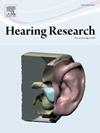2型糖尿病患者耳石器官的功能
IF 2.5
2区 医学
Q1 AUDIOLOGY & SPEECH-LANGUAGE PATHOLOGY
引用次数: 0
摘要
糖尿病(DM)是一种全身性疾病,是一个重大的公共卫生问题。DM引起的内耳微血管和大血管改变可能同时影响听觉和前庭功能。然而,对于糖尿病患者的前庭功能损害缺乏确凿的证据。目前的研究调查了2型糖尿病(T2DM)对前庭系统功能的影响及其持续时间依赖性。方法:80例年龄在40 ~ 70岁之间的个体(T2DM患者40例,同龄健康对照40例)接受颈前庭诱发肌源电位(cemp)和眼前庭诱发肌源电位(oVEMP)对500 Hz音脉冲的响应。他们还接受了姿势和平衡的行为测试。结果:T2DM患者cevemp和oVEMP的应答率及峰间振幅均显著低于健康对照组(p < 0.05)。T2DM组cemp不对称比显著高于对照组(p < 0.05)。T2DM病程、前庭试验异常与姿势、平衡行为试验异常之间无显著相关性(p>0.05)。结论:T2DM患者出现耳石功能障碍的比例相对高于非糖尿病患者。本文章由计算机程序翻译,如有差异,请以英文原文为准。
The functioning of otolith organs in individuals with type-II diabetes mellitus
Aim
Diabetes mellitus (DM), a systemic disease, is a major public health concern. It is possible that micro and macrovascular changes in the inner ear due to DM could affect both auditory and vestibular functioning. However, there is a lack of conclusive evidence for vestibular impairment in individuals with DM. The current study investigated the effects of Type 2 diabetes mellitus (T2DM) on the functioning of the vestibular system and its duration dependency. Methods: Eighty individuals in the age range of 40-70 years (40 with T2DM and 40 age-matched healthy controls) underwent cervical vestibular evoked myogenic potential (cVEMP) and ocular vestibular evoked myogenic potential (oVEMP) in response to 500 Hz tone-burst. They also underwent behavioral tests of posture and equilibrium. Results: Response rates and peak-to-peak amplitude of cVEMP and oVEMP were significantly lower in T2DM than in the healthy controls (p<0.05). Additionally, the asymmetry ratio on cVEMP was significantly higher in T2DM than in the control group (p<0.05). There was no significant correlation between the duration of T2DM, the abnormality in vestibular tests, and abnormalities in the behavioral tests for the posture and equilibrium (p>0.05). Conclusions: A relatively higher proportion of individuals with T2DM show otolith dysfunction than non-diabetic individuals.
求助全文
通过发布文献求助,成功后即可免费获取论文全文。
去求助
来源期刊

Hearing Research
医学-耳鼻喉科学
CiteScore
5.30
自引率
14.30%
发文量
163
审稿时长
75 days
期刊介绍:
The aim of the journal is to provide a forum for papers concerned with basic peripheral and central auditory mechanisms. Emphasis is on experimental and clinical studies, but theoretical and methodological papers will also be considered. The journal publishes original research papers, review and mini- review articles, rapid communications, method/protocol and perspective articles.
Papers submitted should deal with auditory anatomy, physiology, psychophysics, imaging, modeling and behavioural studies in animals and humans, as well as hearing aids and cochlear implants. Papers dealing with the vestibular system are also considered for publication. Papers on comparative aspects of hearing and on effects of drugs and environmental contaminants on hearing function will also be considered. Clinical papers will be accepted when they contribute to the understanding of normal and pathological hearing functions.
 求助内容:
求助内容: 应助结果提醒方式:
应助结果提醒方式:


